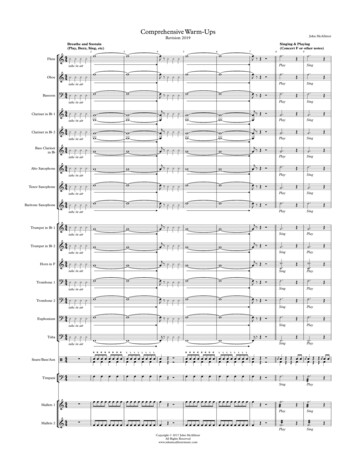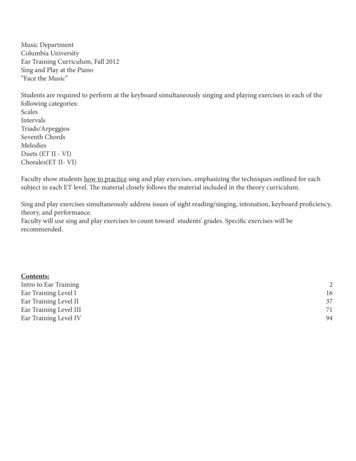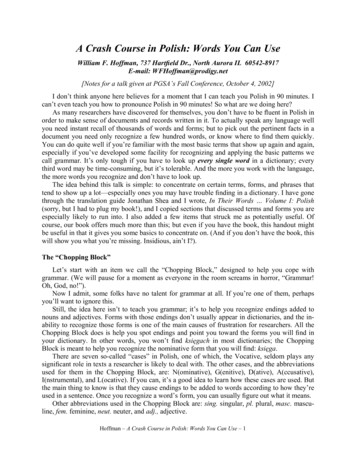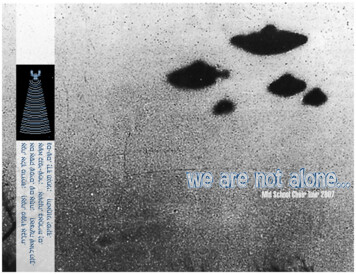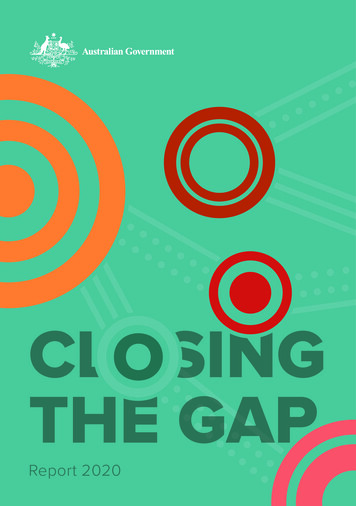
Transcription
CLOSINGTHE GAPReport 2020
CLOSINGTHE GAPReport 2020
ContentsPrime Minister’s Foreword 3Closing the Gap 2020 5Child Mortality 15Early Childhood Education 23School Attendance 33Literacy and Numeracy 45Year 12 Attainment 57Employment 65Life Expectancy 77References 87Technical Appendix 93
2 Closing the Gap Report 2020
PrimeMinister’sForewordThis year, the Closing the Gap report marks a new era. An era of partnership based on anhistoric agreement with Aboriginal and Torres Strait Islander people.Last year, I hoped this report would be on a new Closing the Gap framework. But, this is not aprocess we should rush. Getting it right is worth the time it takes. So while we don’t yet have anew framework in place, a new process has begun. A process that is truthful, strengths-based,community-led, and that puts Aboriginal and Torres Strait Islander people at the centre.In March 2019, I entered into the Partnership Agreement on Closing the Gap, a landmarkagreement to work together to develop the new Closing the Gap framework. It’s a commitmentby the Commonwealth, all states and territories, the Australian Local Government Associationand the Coalition of Aboriginal and Torres Strait Islander Peak Organisations to work together ingenuine partnership.This is no small achievement. For the first time, we have constructed something that sits at thevery centre of government and demonstrates a strong commitment to Indigenous Australianshaving a real say.That’s what was missing from the original Closing the Gap framework. As we turn the last pageon that framework, we take the evidence of the last twelve years and provide the final results.These results are not what we had hoped for, and it’s important to acknowledge them. But it’salso important to celebrate the stories and successes that lie beyond the targets. On almostevery measure, there has been progress.Prime Minister’s Foreword 3
There have been heartening improvements in key areas of health and education. These are thethings that create pathways to better futures.It’s clear we have more to do, but we must do things differently. Without a true partnershipwith Aboriginal and Torres Strait Islander people, we will hamper our own progress.The new framework is based on true partnership, and on a commitment by all governmentsto work together, and to work with Aboriginal and Torres Strait Islander people.The new Joint Council on Closing the Gap is developing priorities, realistic targets and metricsthat all governments and the Coalition of Peaks can commit to achieving. At the core of this newprocess is the expertise of Aboriginal and Torres Strait Islander people, guiding local action andlocal change.Our refreshed Closing the Gap will focus on how we deliver services, as well as what isbeing delivered, and on solutions, not problems.This means changing the way we work. It means expanding the opportunities for shareddecision-making and making sure all mainstream agencies provide high quality programs andservices. It means making sure Aboriginal and Torres Strait Islander people have better access tohigh-quality services, including building community-controlled sectors, and ensuring we have thedata needed for ongoing improvement. It means making sure we have the systems in place toshare responsibility, and to measure our progress. Without this, we can have no meaningful actionand no real progress.For example, we are investing in Aboriginal and Torres Strait Islander-led data to supportdecision-making at a local level. This will mean richer data to build programs that work for peoplein the place they live. It will also help to develop regional profiles to better understand how we aretracking towards Closing the Gap targets and other community priorities.In making this commitment, together we have made a new path. Together we are setting outtowards a goal we all share: that is, for every Aboriginal and Torres Strait Islander child to growup with at least the same opportunities in life as every other Australian.I look forward to honouring our commitment to partnership. I want to make sure IndigenousAustralians are genuinely positioned to make informed choices, forge their own pathways andreach their goals. I want to make sure all governments renew our efforts to help close the gap.We can all play a part. Together we can all improve the lives of Aboriginal and Torres Strait Islanderpeople in this generation and the next.4 Closing the Gap Report 2020
Closing theGap 2020OverviewClosing the Gap began in response to a call for governments to commit to achieving equality forAboriginal and Torres Strait Islander people in health and life expectancy within a generation.It is the story of a collective journey—a shared commitment to empower Aboriginal andTorres Strait Islander people to live healthy and prosperous lives.In 2020, there is a greater focus on partnership between governments and Aboriginal andTorres Strait Islander people. At the centre of this new way of working is local action, and adetermination to make a difference and to achieve change. This Closing the Gap report pointsto the future, a new path where Aboriginal and Torres Strait Islander people share ownershipto improve life outcomes for current and future generations. It closes off on an era of reportingagainst targets set by governments.In partnership with Aboriginal and Torres Strait Islander people, we are moving towards a newNational Agreement on Closing the Gap setting out priorities for the next ten years.Overview 5
Closing the GapIn 2017, the Government began a process to refresh the Closing the Gap agenda. A SpecialGathering of prominent Aboriginal and Torres Strait Islander Australians called for the next phaseto deliver a community-led, strengths-based approach. Aboriginal and Torres Strait Islander peopleare at the centre of this new strategy.Recognising a formal partnership between government and Aboriginal and Torres Strait Islanderpeople would achieve greater progress in the future, the Prime Minister sought agreement fromthe Council of Australian Governments (COAG) to a new way of working.In 2019, all levels of government and a Coalition of Aboriginal and Torres Strait Islander PeakOrganisations signed a formal agreement to work in genuine partnership. This means sharedaccountability and jointly developing an agreed framework and new targets. The Partnership ishelping to capture the aspirations and priorities of Aboriginal and Torres Strait Islander individualsand communities in the design of policies and programs which impact them.The significance of this new partnership is reflected in the establishment of the Joint Council onClosing the Gap. This is the first time a COAG Ministerial Council has included non-governmentrepresentatives.As governments work in this new way, there is increasing involvement and support forlocal communities to set their own priorities and tailor services to their unique contexts.The Indigenous-designed and led Empowered Communities initiative, which is reshaping therelationship between Indigenous communities and governments, is just one example. In acommitment to devolving decision-making as close to the ground as possible, community leadersare directly involved in making recommendations to government about how services and fundingalign with community priorities. Transparency and data sharing informs a ‘learn and adapt asyou go’ approach and underpins local action.Annual report on progress in Closing the GapIn 2007, Commonwealth, state, territory and local governments made a commitment to worktogether to close the gap in Indigenous disadvantage. This led to the National Indigenous ReformAgreement, a significant step toward more coordinated action.The first Closing the Gap framework outlined targets to reduce inequality in Aboriginal andTorres Strait Islander people’s life expectancy, children’s mortality, education and employment.The commitment focused on delivering policies and programs across fundamental ‘building blocks’as priority areas, which would underpin improvement. These were: early childhood, schooling,health, economic participation, healthy homes, safe communities, and governance and leadership.6 Closing the Gap Report 2020
The Commonwealth Government has delivered an annual report on progress on Closing the Gapsince the National Indigenous Reform Agreement was established.There has been good progress made in early childhood education. The target to ensure95 per cent of all Aboriginal and Torres Strait Islander four year-olds are enrolled in earlychildhood education by 2025 is on track, with 86.4 percent of children enrolled in 2018.This means more Aboriginal and Torres Strait Islander children are getting access to learningopportunities that will set them up for a better future. Early childhood is a time of importantcognitive and social development. The achievement of this target sets up children to achievebetter outcomes across their lives.Connected Beginnings is an example of a program that has contributed to progress on this target.Integrating early childhood health, education and family support services, including fundinglocal Aboriginal and Community Controlled Health Services to undertake outreach activitieson school grounds, it provides children and families with holistic support and timely access toexisting services. This helps children meet the learning and development milestones necessaryto thrive and make a positive transition to school. There are funded initiatives in 15 Indigenouscommunities across Australia, with many sites reporting that it has been instrumental in laying thefoundation for increased participation in preschool and early childhood education.The target to halve the gap in Year 12, or equivalent, attainment for Indigenous Australiansaged 20–24 by 2020 is also on track. Year 12 attainment is an important achievement in itself,but it is also a stepping stone to higher education and employment, opening the door to abreadth of opportunities for young people. This is promising for Indigenous employment that hasimproved slightly but not enough to meet the target. For Indigenous Australians with higher levelsof education, there is virtually no gap in employment rates.Regional University Centres, such as the Wuyagiba Bush Hub Aboriginal Corporation in theNorthern Territory, are focused on supporting young people to access higher education oncountry. Under the leadership of local Elder Kevin Rogers, and Dr Emilie Ens of MacquarieUniversity, the Wuyagiba Bush Hub is providing a curriculum that includes cultural contentinterwoven with academic skills. In 2019, nine students completed the university preparationcourse—five of these students have been offered places at Macquarie University and theremaining four at Batchelor Institute of Indigenous Tertiary Education.Chloe Backhouse, a proud Weilwan and Gamilaroi woman living in Sydney, is benefitting fromprograms being delivered as part of the Closing the Gap commitment. Chloe participated andsuccessfully completed a traineeship with Camden Council. Chloe learned valuable office andcustomer service skills while studying for a Certificate III in Business Administration and workingat the Camden Council. This experience gave Chloe a strong foundation on which to build a careerand led to employment.These are examples of programs being delivered at a local level to make a real difference in thelives of Aboriginal and Torres Strait Islander people. They are all achievements to be celebrated,especially the personal successes of participants. But there remains more to be done.Overview 7
The child mortality rate for Aboriginal and Torres Strait Islander children has reduced slightly since2008, and risk factors related to this target have improved, including attendance at antenatal careand reduced smoking during pregnancy. However, as mortality rates for non-Indigenous childrenhave also improved, this has not yet translated into stronger improvements in Indigenous childmortality rates, and the gap has not narrowed.Targets to close the gap in school attendance and halve the gap in reading and numeracy andemployment by 2018 were not met, although there has been improvement in reading andnumeracy and the gap has narrowed across all year levels. More Aboriginal and Torres StraitIslander children are exceeding national minimum standards better positioning them to transitionto further study and work. However, about one in four Indigenous children in Years 5, 7 and 9remain below the national minimum standards in reading, and one in five in Year 3 remain belowthe national minimum standard in reading.Since 2006 there has been an improvement in Indigenous mortality rates, driven primarily byimprovements in one of the leading causes of death, circulatory disease. However, non-Indigenousmortality rates have improved at a similar pace and the gap has not narrowed. Of concern is aworsening of cancer mortality rates. The Tackling Indigenous Smoking program seeks to addresssmoking-related cancer and other diseases. It is also Aboriginal-led, community focused andplace-based. Local campaigns, such as the one developed by the Flinders Island AboriginalAssociation Incorporated, use the experience of local residents and transform communitymembers into champions. Daily smoking among Indigenous Australians aged 15 years andover has decreased from 41 per cent in 2012–13 to 37 per cent in 2018–19.While on almost every measure, there has been progress, achieving equality in life expectancyand closing the gap in life expectancy within a generation is not on track to be met by 2031.Aboriginal and Torres Strait Islander people still have a lower life expectancy thannon-Indigenous people.The Commonwealth, with the National Aboriginal Community Controlled Health Organisation,and the Australian Medical Association, have negotiated a Primary Health Care Funding Modelunder the Indigenous Australians’ Health Programme. Over three years, a new funding modelwill work to deliver primary health care that is appropriate to the unique culture, language,and circumstances of Aboriginal and Torres Strait Islander people. In developing a newfunding model, the Aboriginal Community Controlled Health Service sector informed the designand it is changing the funding model that distributes primary health care grants.Progress in the overarching life expectancy target is dependent not only on further progress inhealth, but also in other outcomes such as education, employment, housing and income. There ismore work to be done to close the gap in health inequality, including by harnessing the strengthof culture as an underlying determinant of good health through identity and belonging, supportiverelationships, resilience and wellbeing.Although it is concerning not all targets have been met, there are positive signs that workingtogether can accelerate progress and achieve better outcomes.8 Closing the Gap Report 2020
The chapters that follow provide more detail on the most recent data against each of the seventargets. They show many Aboriginal and Torres Strait Islander people continue to experiencedisparity with non-Indigenous people in important areas of their lives. That disparity is evengreater for people living in remote areas. It is important to acknowledge the truth of this,and continue to build better data at the regional level and expand opportunities forshared decision-making, so that we move forward with a clear understanding of the challenge.Working in Partnership and a new frameworkfor Closing the GapTo rise to this challenge, the Closing the Gap framework is moving toward a strengths-basedagenda—one that partners with Aboriginal and Torres Strait Islander people, enables morecommunity control and embeds shared decision-making.The Commonwealth, state, territory governments, and the Australian Local GovernmentAssociation, in partnership with representatives of the Coalition of Aboriginal and Torres StraitIslander Peak Organisations, are working to develop the new Closing the Gap framework andtargets to set the direction for the next ten years.“Never have Aboriginal and Torres Strait Islander peak bodies from across thecountry come together in this way, to bring their collective expertise, experiences,and deep understanding of the needs of our people to the task of closing the gap We have an unprecedented opportunity to change the lived experience of too manyof our people who are doing it tough.”Ms Pat Turner AM, CEO of the National Aboriginal Community ControlledHealth OrganisationThe new national agreement will be one where all parties commit to achieving the prioritiesand targets—where there is greater accountability to Aboriginal and Torres Strait Islandercommunities for progress.Aboriginal and Torres Strait Islander people who participated in consultations during the Closingthe Gap Refresh process expressed their desire for a strong and inclusive partnership and agreater say in the design and delivery of programs and services. The partnership is changing theconversation. It is becoming clear that priorities for the future involve creating more opportunitiesfor shared decision-making, improving access to and collection of data to increase transparency,building the Aboriginal and Torres Strait Islander community-controlled services sector, andensuring all mainstream institutions deliver programs and services that meet the needs ofAboriginal and Torres Strait Islander people.A framework will be developed to incorporate these important elements, and provide indicatorsto monitor progress toward outcomes, and incorporate regular independent oversight ofimplementation.Overview 9
Stories of local action to create changeThere are many examples that demonstrate what can be achieved at a local level whengovernments work with Aboriginal and Torres Strait Islander people.A partnership in New South Wales and Victoria is making a real difference to employmentopportunities for Aboriginal and Torres Strait Islander people. As part of the Echuca/MoamaAboriginal Workforce Development Strategy a steering committee of industry, land councils, eldersand community leaders, and all levels of government has worked together to deliver 45 new jobs.The Jawoyn Association Aboriginal Corporation is another example of all levels of government,business, local Aboriginal people and the non-government sector working together to stimulatethe local economy and improve social outcomes.The Multi-Agency Partnership Agreement between the Gurindji Aboriginal Corporation, NorthernTerritory Government and the National Indigenous Australians Agency is also delivering realbenefits to the local people of Kalkaringi. The partnership has resulted in six new local jobsand delivery of key infrastructure projects to upgrade housing and community facilities. It alsosupports the continuation of the Freedom Day Festival celebrating local culture and history,commemorating the Wave Hill walk off which put Aboriginal land rights onto the national agendain the 1960s, and is a significant source of revenue for the community.These examples show that it is possible to work together more effectively to get tangibleoutcomes.For more than a decade, Commonwealth, state, territory and local governments, Aboriginal andTorres Strait Islander and non-Indigenous organisations, and Aboriginal and Torres Strait Islandercommunities have been working to improve outcomes. Some progress has been made and astronger partnership approach will accelerate these improvements, with Aboriginal and TorresStrait Islander people taking greater ownership over the design, development and delivery ofpolicies and programs that impact their lives.In 2005, the Aboriginal and Torres Strait Islander Social Justice Commissioner’s reportrecommended that Commonwealth, state, territory and local governments commit to achievingequality in health and life expectancy outcomes within 25 years. The data contained in this reportshows that more work is needed. These are complex issues needing persistence and flexibility.We have seen that solutions are most successful when they are led by Aboriginal and Torres StraitIslander people. A genuine partnership with Aboriginal and Torres Strait Islander people, whichvalues their expertise and lived experience, is integral to achieving equality in life outcomes.Closing the gap was expected to take a generation—the effort must continue.10 Closing the Gap Report 2020
Progress against the TargetsProgress against the Closing the Gap targets has been mixed over the past decade.As four targets expire, we can see improvements in key areas, but also areas of concern thatrequire more progress. The target to halve the gap in child mortality rates by 2018 has seen progressin maternal and child health, although improvements in mortality rates have notbeen strong enough to meet the target. The target to halve the gap for Indigenous children in reading, writing andnumeracy within a decade (by 2018) has driven improvements in thesefoundational skills, but more progress is required. There has not been improvement in school attendance rates to close the gapbetween Indigenous and non-Indigenous school attendance withinfive years (by 2018). The national Indigenous employment rate has remained stable against thetarget to halve the gap in employment outcomes between Indigenous andnon-Indigenous Australians within a decade (by 2018).Two of the continuing targets are on track. The target to have 95 per cent of Indigenous four year-olds enrolled in earlychildhood education by 2025. The target to halve the gap for Indigenous Australians aged 20–24 in Year 12attainment or equivalent by 2020.However, the target to close the gap in life expectancy by 2031 is not on track.Jurisdictions agreed to measure progress towards the targets using a trajectory, or pathway,to the target end point. The trajectories indicate the level of change required to meet the targetand illustrate whether the current trends are on track. See the Technical Appendix for furtherinformation.Overview 11
When the Council of Australian Governments established the National Indigenous ReformAgreement (NIRA) as a framework for the Closing the Gap targets, it was recognised thatimprovements in data quality were necessary to support reporting and measurement of progress.Work has been undertaken to improve the data collections that inform the targets, such as theCensus, deaths registrations, and the perinatal data collection.The need to continuously improve the quality of the data is important for strengthening theevidence base. However, this also impacts upon the measurement of outcomes and poseschallenges for interpreting trends in the targets. These issues are touched on in the reportand in the Technical Appendix.Trend results in this report are statistically significant, unless indicated otherwise.See the Technical Appendix for more information.Progress across states and territoriesProgress against the targets for each state and territory varies, and is summarised in Table 1.1.This table serves as a guide to progress, but should not be used in isolation as there are limitationsfor each target trajectory, and for the data sources used to measure outcomes. More detailedanalysis of progress in each of the target areas is found in the chapters of this report.12 Closing the Gap Report 2020
Table 1.1Progress against the targetsaTargetChild mortality ��———AUSEarly childhood education (2025)School attendance (2018)Literacy and Numeracy (2018)cYear 12 or equivalent (2020)dEmployment (2018)eLife expectancy (2031)f——Notes: (a) A blue box indicates the target is on track. A dash indicates the data is either not published or thereis no agreed trajectory. The other targets are not on track or have not been met. For more information on thetarget trajectories see the Technical Appendix.(b) Due to the small numbers involved, state and territory trajectories were not developed for the childmortality target. The national target reflects results for New South Wales, Queensland, South Australia,Western Australia and the Northern Territory combined, which are the jurisdictions considered to haveadequate levels of Indigenous identification in the deaths data suitable to publish.(c) For the purposes of this summary table, states and territories are considered to have met the target ifmore than half of the eight National Assessment Program – Literacy and Numeracy (NAPLAN) areas(Years 3, 5, 7, and 9 reading and numeracy) were met in each jurisdiction.(d) The Census is the primary data source for the target which was published in the 2018 Closing theGap Report.(e) Progress against trajectories for the employment target was assessed using the 2018–19National Aboriginal and Torres Strait Islander Health Survey data.(f) Estimates of Aboriginal and Torres Strait Islander life expectancy are published every five years forNew South Wales, Queensland, Western Australia and the Northern Territory only. Due to the small numberof Aboriginal and Torres Strait Islander deaths in Victoria, South Australia, Tasmania and the AustralianCapital Territory, it is not possible to construct separate reliable life tables for these jurisdictions. However, asindicated in the table, only three jurisdictions have agreed life expectancy trajectories to support this target.Overview 13
14 Closing the Gap Report 2020
ChildMortalityTargetHalve the gap in mortality rates for Indigenouschildren under five within a decade (by 2018)Key points In 2018, the Indigenous child mortality rate was 141 per 100,000—twice the ratefor non-Indigenous children (67 per 100,000). Since the 2008 target baseline, the Indigenous child mortality rate has improved slightly,by around 7 per cent. However, the mortality rate for non-Indigenous children hasimproved at a faster rate and, as a result, the gap has widened. Some of the major health risk factors for Indigenous child mortality are improving.There is a need for further research to understand why these improvements havenot translated into stronger improvements in Indigenous child mortality rates.Child Mortality 15
What the data tells usNationalTragically, in 2018, there were 117 Indigenous child deaths. This was equivalent to a rate1of 141 per 100,000—twice the rate for non-Indigenous children (67 per 100,000). This wasnot within the range required to meet the target (94 per 100,000) (Figure 1.1).Maternal health is a key driver for this target, and health outcomes for Indigenous mothersand children have improved over the past decade. However, this has not translated into strongerimprovements for Indigenous child mortality rates. Further research (including data linkage)is required to understand why. This is discussed in more detail below at Factors that influenceIndigenous child mortality.Indigenous child mortality rates have improved (by 7 per cent) between 2008 and 2018.2 However,this improvement was not as strong as prior to the 2008 baseline.3 Non-Indigenous child mortalityrates also improved between 2008 and 2018, and at a faster rate than for Indigenous children.Therefore, the gap between Indigenous and non-Indigenous child mortality rates has widened.Over the period 2014 to 2018, the main cause of Indigenous child deaths was perinatal conditions(49 per cent), such as complications of pregnancy and birth. Most Indigenous child deaths(85 per cent) occurred during the first year of life. This was similar for non-Indigenous children.This is discussed in more detail below at Causes of death.16 1The child mortality rate is defined as the number of deaths among children aged 0–4 years old as a proportion of the totalnumber of children in that age group, presented as a rate per 100,000 population. Note that the number of Indigenous childdeaths is volatile from year to year.2This result was not statistically significant. References to per cent change in mortality rates in this chapter are derivedthrough linear regression analysis, and tested at the 5 per cent level of significance. For details on the specifications forthe child mortality indicator used in this report, refer to the National Indigenous Reform Agreement data specifications onthe Australian Institute of Health and Welfare (AIHW) METeOR website.3Data quality issues may overstate the early declines from 1998 to 2008. See the Data notes and the Technical Appendix forfurther information.Closing the Gap Report 2020
Figure 1.1Child mortality rates, 0–4 years old, 1998–2018a, b, cDeaths per 100,000Deaths per 2002200420062008YearIndigenous rateNon-Indigenous rateIndigenous trajectoryIndigenous trajectory band201020122014201620180TargetSources: Australian Bureau of Statistics and Australian Institute of Health and Welfare analysis of the NationalMortality Database, unpublished, and National Indigenous Reform Agreement Performance InformationManagement Group, unpublished.Notes: (a) Child mortality rates are based on data for New South Wales, Queensland, South Australia,Western Australia and the Northern Territory combined.(b) The Indigenous trajectory indicates the level of change required to meet the target. The trajectory hasbeen revised to include the 2016 Census-based backcast population estimates. Consequently, the target hasalso been revised to reflect the result needed to halve the gap (as measured at the 2008 baseline).(c) The low Indigenous child mortality rate in 2012 is likely to reflect the unusually large number of Indigenousinfant deaths that occurred in 2012, but were registered in 2013. This also results in an overstating ofmortality rates in 2013. In 2015, Queensland included Indigenous status from the Medical Certificate ofCause of Death which led to an increase in the number of deaths identified as Indigenous. Although this wasan improvement in data quality, it con
Overview 5 Closing the Gap 2020 Overview Closing the Gap began in response to a call for governments to commit to achieving equality for Aboriginal and Torres Strait Islander people in health and life expectancy within a generation.

